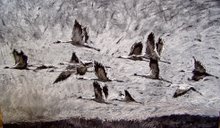


So when you train dogs for basic obedience or agility, it's important to focus on your intent. You want to have a clear vision of what it is you want the dog to do, then use your body language as well as the command to communicate that to the dog. This clarity is also important reinforcement of alpha-dom; anytime the dog thinks it might be the one driving the bus, so to speak, your ability to keep the message clear and simple makes a world of difference.
Before I begin a painting I always have a focus; a mood, an atmosphere, a focal point, whatever it is I want to achieve with that piece is at the top of my mind. Occasionally it's so clear from the beginning, like with this piece, that it is difficult to figure out what the next step might be. The under-painting had such dynamic marks and mood to it, but it was not finished. Taking it to the next step was really tricky because I didn't want to lose that freshness. Somewhere along the way I lost the focus and that dog ran away from me. After repeated calling and a lot of treats (for the artist in this case...) I got it back. I had to spend about a week without painting, re-focusing, thinking about what the core of this piece was about.
In the end the painting is somewhere in-between: it isn't as fresh and as raw as it was initially, but it is defined enough to feel finished.
I will never be the kind of dog person whose dog is always well-behaved and orderly. I think that obedience is necessary for good dog citizens and for their own safety and well-being; but I also like them to be dogs and have fun. This is so true of my art as well. There are some 'rules' that help make a painting successful, but you have to understand that at some point that sucker will run away from you, chase a seagull down the beach, and find something stinky to roll in before coming back to you.
Title of this piece is "Elwha Maples." Oil on canvas, 36x48". The top image is the under-painting, the bottom is the finished piece.
























